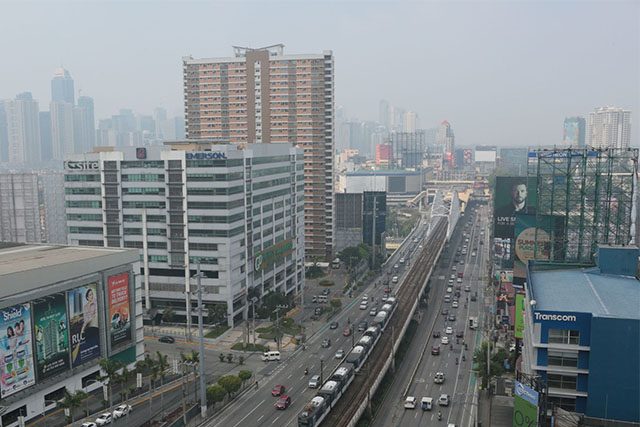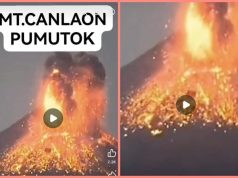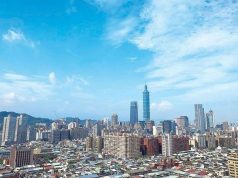
Filipinos admitted to being confused after state volcanologists clarified that the haze being experienced in Metro Manila is due to the air pollution and not because of the volcanic smog emitted by Taal Volcano.
The Philippine Institute of Volcanology and Seismology on Tuesday denied that the Batangas-based volcano is the culprit behind the unclear surroundings that Filipinos have been experiencing in the capital region recently.
“The haze which is being experienced by some residents of Metro Manila is smog caused by pollution and human activity. The haze is not from Taal Volcano,” it said on social media.
“As such, the haze that is being experienced in the NCR may be mainly due to smog, or industrial air pollution, rather than vog, although we cannot completely rule out additional [sulfur dioxide] albeit very minor at this point,” Phivolcs said in a separate e-mail to ABS-CBN News.
State volcanologists on Monday had warned residents living near the volcano to take precautions against volcanic smog (or vog) after observing high levels of volcanic sulfur dioxide gas emissions and plumes as high as 3 kilometers from its main crater “for the past few days.”
The volcanologists said that on Sunday it has recorded an average of 4,711 tonnes of sulfur dioxide emission per day.
“Should SO2 gas emission continue at the same rate (past week average of ~4,330 tonnes/day) or increase and atmospheric conditions promote the formation of vog, communities surrounding Taal Lake are advised to take necessary precautions,” the agency said on the same day.
Phivolcs also advised residents to avoid outdoor activities, close their windows and doors and don N95 face masks to prevent exposure to the volcanic gas that can irritate the eyes, throat and respiratory tract, among others.
While it didn’t mention Metro Manila in its vog advisory, some reports connected the capital region’s hazy surroundings to the phenomenon.
Exactly.. Can they please review their statements first before telling us. It's confusing. pic.twitter.com/fdWZJwCTXf
— ChiiBiChuu (@may_loves_july) June 29, 2021
Around the same time, residents in cities and surrounding areas have reported seeing haze in the atmosphere.
DID YOU NOTICE THIS TOO?
Some parts of Metro Manila, such as Makati and Mandaluyong, are hazier than usual! (Comment your pics if you saw it too!) pic.twitter.com/ru0NFM8Ava
— Greenpeace Philippines (@gpph) June 28, 2021
Some have wondered if it was related to the recent vog reported in Taal Volcano.
Caused by Taal Volcano smog? pic.twitter.com/qZZy7ZUWKg
— AJ Angeles (🙏 for change in the Philippines☹) (@itsajangeles) June 28, 2021
So this is volcanic smog/vog from Taal Volcano?
📍 North Signal Village 8:28 AM pic.twitter.com/xzXx87JGAQ
— Louie Gabriel Ocampo (@iamgabocampo) June 29, 2021
This has prompted some Filipinos to become confused following Phivolcs’ clarification.
“They’re confusing us either way. Phivolcs released an advisory regarding SO2 emissions which, by the way, based on current fair weather conditions, may spread up north. And now, they’re telling us it’s human-activity related?” a Twitter user wondered.
Another online user pointed out that the volcanologists didn’t mention Metro Manila in its vog advisory and said that a statement was made to clarify things “since the media/people have quickly correlated the incidents.”
Metro air pollution, weather
Switzerland-based company IQAir recently reported that the air quality over Manila has reached an “unhealthy” level.
“PM2.5 concentration in Manila air is currently 4 times above WHO exposure recommendation,” it said on its website.
PM2.5 translates to particulate matter of 2.5 microns or less in diameter. It is reported to be the most dangerous kind of airborne pollution in which dust is small enough to enter the bloodstream and cause asthma, heart disease and lung cancer.
Phivolcs Director Renato Solidum Jr. on Tuesday attributed the haze over the metro primarily to vehicle emissions and water vapor from rains in light of the rainy season.
“Vehicle emissions will be the major contributor. (Also), because of thunderstorms, there have been frequent rains all over (Metro Manila). Water has been evaporating since morning as the sun heats the ground,” he told Philippine News Agency.
“The volume of vehicles is increasing. You can see this pollution clearly in the morning when the temperature is cooler as the sun has just risen. The haze is from the ground and moving up, and very evident in major roads. The smog would eventually rise farther up as air temperature would increase during the day,” Solidum added.









